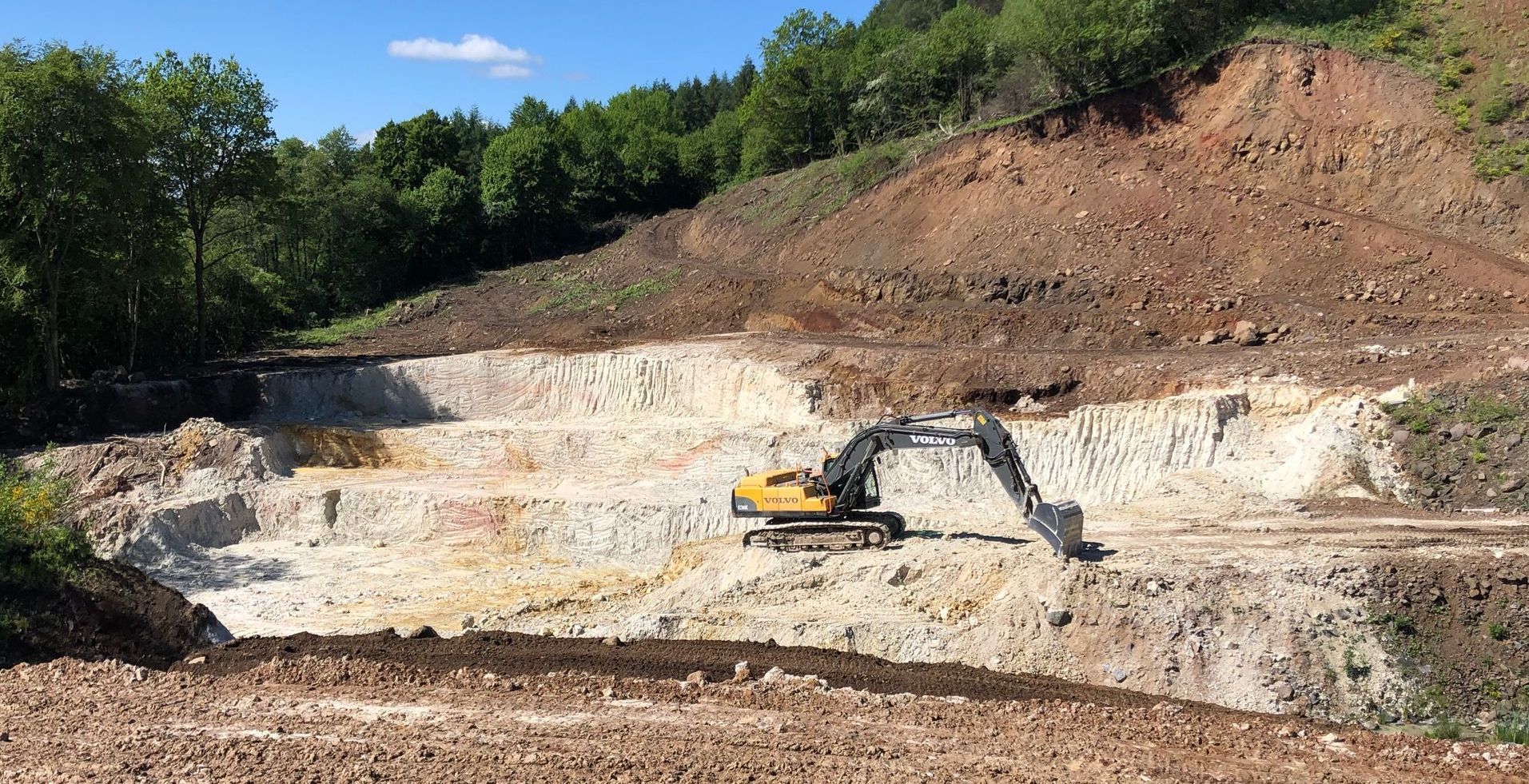Kreuzton
What is Kreuzton?
Kreuzton is a clay quality that is popular and rightly appreciated in ceramics. The name Kreuzton stands for a high-quality, light-firing slate clay that is extracted from the "Auf dem Kreuz" clay pit. For almost 100 years, Theodor Stephan KG has been synonymous with the extraction of Kreuzton. Kreuzton is used in almost all main types of ceramics and has many valuable properties. The occurrence of Kreuzton in our primary deposit is very homogeneous and offers security of supply into the next century.
Kreuzton is a sericitic clay, which is extracted as finely decomposed slate clay from the primary deposit "Auf dem Kreuz" in Burbach/ NRW. Kreuzton is available in finely shredded or powdered form and is selected with different iron oxide contents, resulting in five types of Kreuzton. These have firing colors ranging from white to light, cream to brick red and wine red at higher temperatures. Kreuzton is very homogeneous and free from disruptive impurities such as pyrites, coarse quartz, lime and organic substances. Large storage capacities guarantee delivery reliability at any time of year, even for larger delivery campaigns.
What are the advantages of using Kreuzton?
Kreuzton has many positive properties, which makes it popular for use in all main types of ceramics. Regardless of whether it is for the production of tiles, clinker bricks, roof tiles or flower pots, Kreuzton improves the properties of all ceramic bodies.
Due to the very good mixing and liquefaction behavior, ceramic bodies can be processed much more easily with the addition of Kreuzton. In casting ceramics, the very high body formation rate of Kreuzton shortens the casting cycles. Thanks to its excellent drying properties, the use of Kreuzton saves energy and at the same time prevents deformation and cracks. Thanks to its mineral composition and low shrinkage, Kreuzton is an excellent glaze carrier and can be easily colored. Kreuzton can even be used very well as a component of glazes and engobes.
What is Kreuzton suitable for?
Kreuzton is supplied as sericitic clay in a shredded or powdered state and is suitable for almost all ceramic applications due to its positive properties. Kreuzton is widely used as a body component in ceramic bodies and as engobe or glaze clay for ceramic surfaces.
The very good liquefaction behavior of Kreuzton can be taken advantage of by adding it to bodies and clays. These are much easier to process thanks to the valuable raw material. For example, the castability is improved. The high body formation rate means that casting cycles can be shortened. Kreuzton can also provide optimization in plastic shaping processes. Its exceptional grain distribution ensures an increase in body strength, problem-free demoulding and good crack-free drying behavior.
Kreuzton is appreciated in ceramics because it has a high level of purity and homogeneity. The mineral composition and low shrinkage make Kreuzton an excellent glaze carrier.
What types of Kreuzton are available?
Kreuzton comes in five different types. These differ in their iron oxide content and therefore in their firing color. The other mineral components are almost identical in all Kreuzton types.
Kreuzton white (K100):
Kreuzton white has 0.6% iron oxide and is particularly appreciated due to its white firing color. Even when the firing temperature increases, it only changes color slightly. Kreuzton white K100 is often used in white ceramic products, for example in decorative ceramics, in tableware, in white clinker bricks or in glazes and engobes. (Data sheet)
Kreuzton light (K150):
Kreuzton light has 1.0% iron oxide and, due to its light firing color, is used wherever a light color is desired, for example for tiles or clinker bricks. Kreuzton light K150 can also be easily colored gray or black with manganese oxide and is used in corresponding trend products such as gray brick slips or black pavers. (Data sheet)
Kreuzton cream (K200):
Kreuzton cream has 1.5% oxide and is often used as a bulk component for planters, clinker bricks and tiles. Kreuzton cream K200 is the economical alternative to the lighter Kreuzton types. The firing color varies depending on the firing temperature from soft pink to light gray to a strong gray. (Data sheet)
Kreuzton light red (K400):
Kreuzton light red has 3.5% iron oxide and is used as a mass component for all red-firing ceramic masses. Kreuzton light red K400 offers all the typical advantages of Kreuzton while maintaining high availability. The firing color changes from light red to red as the firing temperature increases. (Data sheet)
Kreuzton red (K700):
Kreuzton red has 7.5% iron oxide and is used as a mass component for intensively red-firing ceramic masses for the production of flower pots, clinker bricks and roof tiles. By adding Manganese clay T880 or manganese oxide, a trendy black firing color can also be achieved with Kreuzton red K700. (Data sheet)
Our service:
We not only supply you with different types of Kreuzton clay, but also in different delivery forms and packaging. The clay can be obtained finely shredded or dried and ground. The delivery form is loose or packed in 1000 kg big bags or in 25 kg paper sacks.



